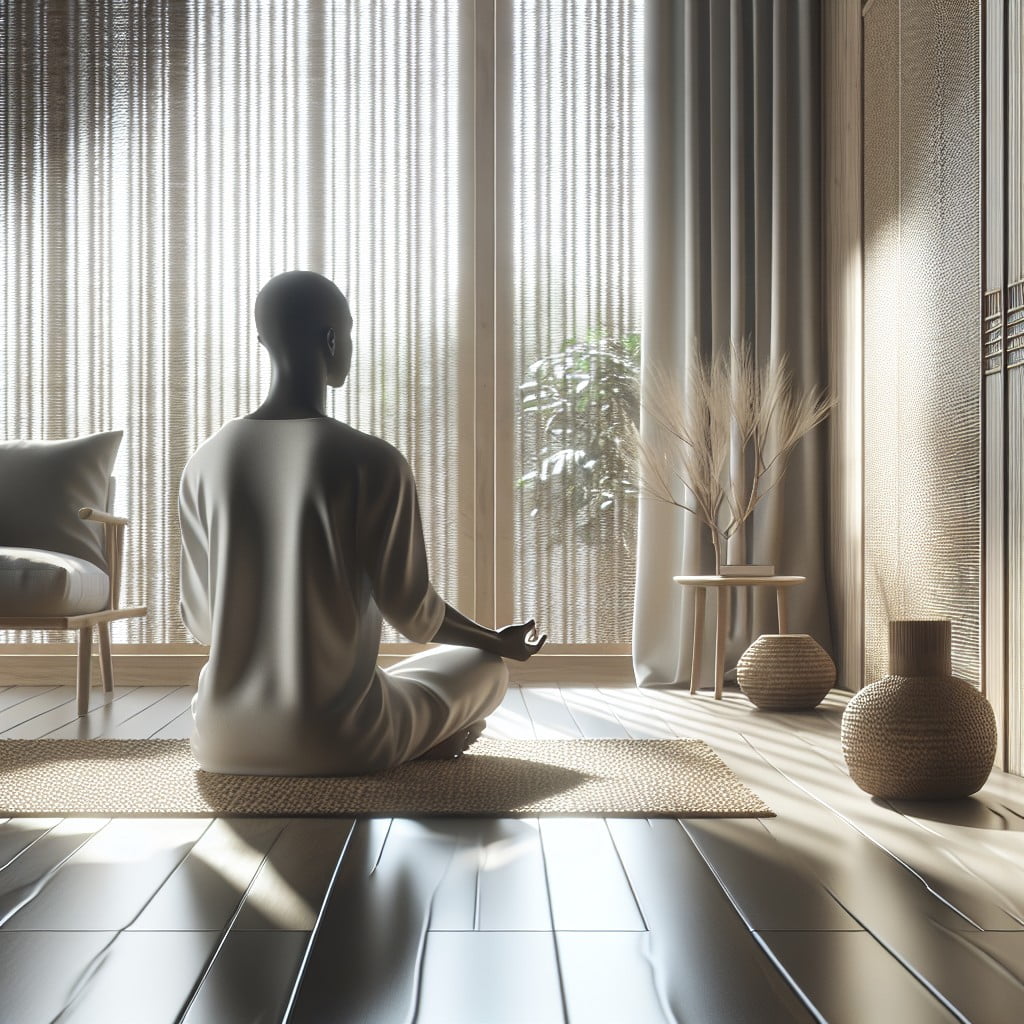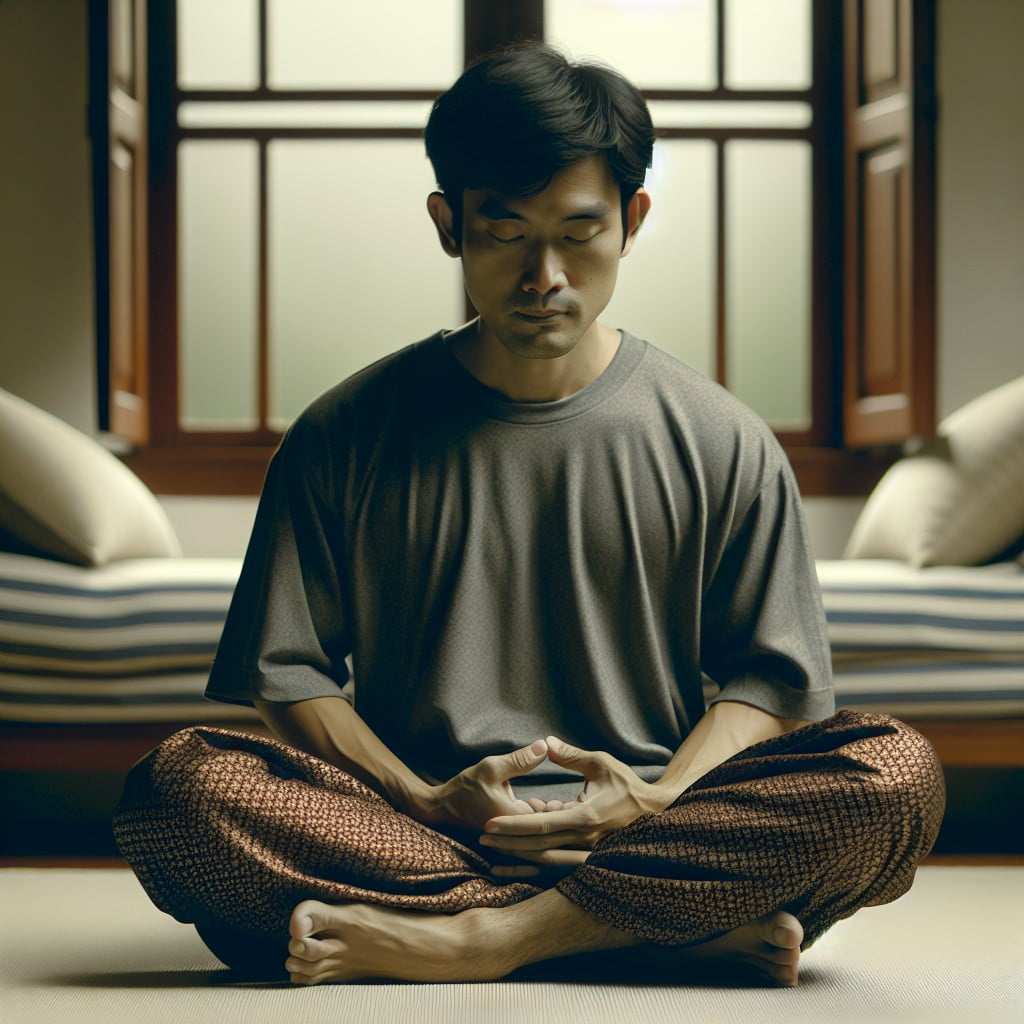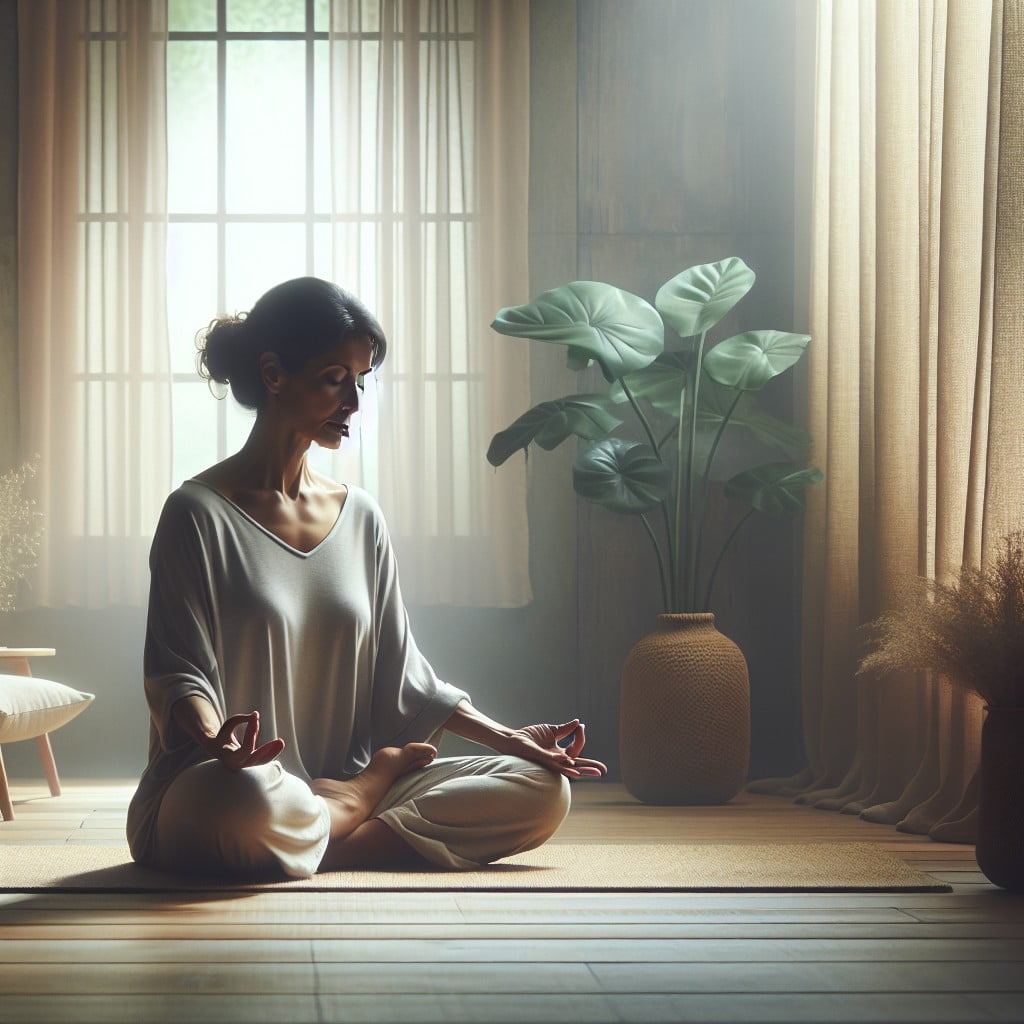Embrace the serenity of Zen meditation at home because it simultaneously offers profound tranquility and an invigorated spirit.
Embarking on a journey of Zen meditation at home can be a transformative experience, offering a sense of peace, clarity, and mindfulness. This practice is rooted in Buddhist tradition, yet its principles are universally applicable, making it an enriching addition to any daily routine.
The beauty of Zen meditation lies in its simplicity. It involves sitting in a quiet and comfortable space, focusing on your breath, and letting go of any thoughts that may arise, without judgement.
This article will guide you through the process step by step, ensuring you understand the nuances and benefits of this practice, and how to incorporate it seamlessly into your life.
Key takeaways:
- Find a quiet location for meditation
- Choose a comfortable posture (Burmese, Half Lotus, Full Lotus, Seiza, Chair)
- Follow the Zazen instructions for meditation practice
- Start with short sessions and gradually increase duration
- Consistency is key for developing mindfulness and clarity
Choosing the Suitable Zen Meditation Position

First and foremost, finding an appropriate location for your practice is vital. A quiet, peaceful space free from distractions is ideal. The spot could be inside or outside, and doesn’t need to be large – just enough for your seated posture.
Your physical comfort is essential; therefore, you might want to use a cushion (zafu) or a meditation bench. A zafu raises the hips, making the cross-legged postures more comfortable, and the bench helps to maintain upright posture, relieving pressure on the knees and ankles and eliminating any discomfort.
Subsequently, decide on an appropriate posture for Zen meditation. There’s a variety of postures you can choose from and we’ll delve into each one, but first, there are few common elements to keep in mind. Your spine should be erect but not stiff, your head upright, and your gaze cast downward with a soft focus. Your mouth should be closed, with the tongue reaching up to meet the roof of the mouth.
The hands form an oval shape, right hand embracing the left, thumbs gently touching at the tips. Your hands rest in your lap, palms up against your abdomen, which enables you to sense the rise and fall of your breath.
These considerations lay the groundwork to properly place the body for Zen meditation. Remember, composure and ease in the posture are key. With these points in mind, let’s explore specific Zen meditation positions.
Understanding the Burmese Position

The Burmese position, rooted in the traditions of Buddhist practice, embodies a key principle of Zen meditation – stability. In this posture, both legs lay flat on the floor, where one leg rests in front of the other but not on top. This technique eliminates elevation, thereby easing any tense feelings around the hip area.
1. Position yourself cross-legged on a meditation cushion.
2. Ensure your knees touch the floor to form a stable tripod base.
3. Let your hands rest comfortably on your lap.
4. Keep an upright but relaxed posture, with your chin slightly tucked in and eyes cast downward.
Practice regularly, focusing on maintaining this posture without straining your body. As your flexibility increases, you may find this position becoming as comfortable as sitting on a chair. The simplicity of the Burmese position offers an accessible way into Zen meditation, fostering both physical comfort and mental focus.
Practicing the Half Lotus Position

In practicing the Half Lotus position, begin by sitting on your meditation mat with both legs extended in front of you. Fold one leg and tuck your foot close to your hip. Ensure you’re comfortable to aid maintaining focus through your practice session. Now, take your other foot and place it on top of your folded leg.
Avoid forcing the position if your legs are not flexible enough yet. Unnecessary strain can take you away from the calm state necessary for effective meditation. With regular practice, flexibility will improve in due time.
Always remember to keep your back straight, embodying the dignified posture of a meditator, but not stiff as it may cause discomfort. Lastly, rest your hands on your thighs, palms-downward to complete the position.
This posture enables deep relaxation yet active engagement conducive to Zen meditation. Bringing you closer to your mindful state with every breath.
Mastering the Full Lotus Position

Renowned for its embodiment of balance and stability, the Full Lotus position involves more flexibility. Its execution begins by placing your right foot on your left thigh and then gently placing your left foot on your right thigh. Your feet should be sitting toward the ceiling—this forms a sort of triangular base that promotes ergonomic posture.
While adopting this position, keep these pointers in mind:
- 1. Sit on a cushion or yoga mat for comfort since maintaining posture could get straining for beginners.
- 2. Ensure your knees touch the floor. It enhances lower body stability and helps maintain posture for longer periods.
- 3. Keep your spine upright, creating a straight line from the base of your spine up to the top of your head.
- 4. Rest your hands on your feet with palms up, or on your thighs—whichever feels more comfortable and balanced.
- 5. Maintain relaxed yet structured posture. Although the Full Lotus position requires discipline, it shouldn’t cause substantial discomfort.
Remember, it’s more important to prioritize comfort over perfect form. If you find the Full Lotus too challenging, opt for an easier position until your flexibility improves. An efficient meditation isn’t determined by the complexity of your pose, but the tranquility of your mind.
Getting Comfortable With the Seiza Position
Adopting the Seiza pose requires a meditation bench or a cushion. To begin, place it between your feet while kneeling and lower your body to sit on your heels. Keep in mind that your big toes should overlap and the cushion or bench should reside between your calves. Your hands can rest palm-down on your thighs, and your gaze should be downward, softly focusing on the floor about a meter ahead of you.
Benefits of the Seiza position include:
- 1. A stable upright posture that aligns the spine.
- 2. Reduces strain on the ankles and knees.
- 3. Suitable for those who find cross-legged positions uncomfortable.
- 4. Encourages proper breathing and promotes tranquility.
Although it may feel unnatural at first, with continued practice, the Seiza position will foster a sense of peace and groundedness. Remember, meditation is not about enduring discomfort, but about finding an enduring comfort in the midst of temporary physical challenges. Adjust position as necessary to ensure your practice experience is both beneficial and comfortable.
Applying the Chair Position for Zen Meditation
To adopt the chair position efficiently, it’s important to choose a chair that provides a stable and sound base. Aim for an upright posture with both feet planted firmly on the floor, aligning your ankles directly under your knees. Allow your hands to rest comfortably in your lap with your spine erect and the top of your head pointing toward the ceiling. Avoid leaning back; instead, balance your weight on the two ‘sit bones’ at the base of your pelvis. This allows a natural curvature in your spine and, in turn, promotes alertness during Zen practice. Mindfulness in maintaining this posture can significantly heighten your meditation experience.
Following the Zazen Instructions for Home Practice
Begin your session by choosing a quiet spot free from distractions. Arrange your preferred seating position, from the ones we previously discussed, such as a meditation cushion or chair. Your posture plays an essential role in reinforcing attentiveness. Ensure your spine is upright, your chin slightly pulled in, with eyes half-closed.
Focus attention on your breath. Breathe naturally as you bring mindful awareness to the inhalation and exhalation process. Take note, the aim is not to control your breathing but rather witness and appreciate it.
Your mind may wander, filled with thoughts or emotions. Fear not, for this is a usual occurrence in meditation. Simply observe these thoughts without judgment and then gently guide your attention back to your breath.
Using a timer can be quite helpful, especially in the early stages. Start by meditating for as little as 5 minutes per day, gradually increasing the duration as your practice deepens.
Lastly, consistency is the key. Make it a point to dedicate some time daily for your practice. Even on hectic days, find a moment to devote to focus and centeredness. Practicing Zazen at home allows you to develop mindfulness, gain mental clarity and improve overall well-being.
FAQ
How do I start Zen meditation?
To start Zen meditation, find a comfortable spot where you can sit upright, then focus on your breathing, allowing thoughts to flow freely and refocusing on your breath when distractions arise.
What is the Zen method of meditation?
Zen meditation is a practice focusing inward attention, often conducted in a sitting position such as the lotus position, aimed at thought regulation and nurturing the concept of "thinking about not thinking".
How long should you meditate for Zen?
The typical duration for Zen meditation ranges from 30 to 45 minutes a day, with many Zen centers recommending 40 minutes.
What are the key principles of Zen meditation?
Zen meditation, also known as Zazen, revolves around the principles of observing the breath and mind, sitting with upright posture, and adopting an attitude of open awareness without judgment or attachment to thoughts.
How does Zen meditation impact mental and physical health?
Zen meditation improves mental health by reducing stress and anxiety, enhancing concentration and mindfulness, and boosts physical health by lowering blood pressure, improving breathing and promoting overall wellbeing.
Can Zen meditation techniques be incorporated into a daily routine easily?
Yes, Zen meditation techniques can be seamlessly incorporated into a daily routine as they require minimal effort and time.